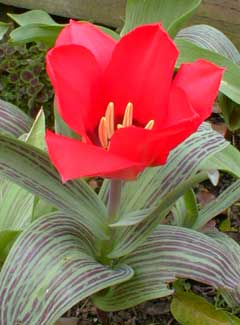 'Red Riding Hood' Tulip
'Red Riding Hood' Tulip
"Why is the Tulip's cheek red
like fire & blood?"
-Jalaluddin Rumi
(1207-1273)
(1207-1273)
Tulipa greigii 'Red Riding Hood' is in bloom through much of April, when the daffodils have already been up for a while. It is a pretty presence in the garden well before blooming, as by February the red-striped leaves are decorative in & of themselves.
The species is native to Turkistan. The whimsically named 'Roodkapaje' i.e., 'Red Riding Hood,' was introduced in 1953 by a Dutch firm. It has remained much the most popular greigii tulip offered. The photo shows it just before all the petals are completely open. The blazing crimson blooms are underscored by the red strips of the leaves.
I first planted a drift of 'Red Riding Hood' in 2001 & it did splendidly, but by their third year the area became increasingly shady from surrounding shrubs. They bloomed relatively nicely during their third spring even so, but the flowers were closed longer due to being shaded, & were getting increasingly difficult to see & to fully appreciate as other plants hemmed them round.
Then to top it off, when they had gone dormant, a mole shoved many of the bulbs to the surface. That seemed to be the final cue that the bulbs should be lifted. The entire section of Greigiis was moved to a roadside sun garden, where three varieties, formerly in little drifts of their own, got all shuffled together (the other two were 'Chopin' & the orange 'Oratorio.').
As the bulbs were lifted, it was great to see how very many offsets 'Red Riding Hood' had produced, being longest in its first location. The move for all these bulbs, however, was not to the best-chosen place. They had been in moist, shady circumstances & needed more sun, but not less moisture. The roadside garden was dry & hot, & the bulbs survived but did not produce spectacularly. So in autumn 2004 I obtained some fresh bulbs & put those in a more ideal location within the reach of regular watering & with pretty good sun exposure.
'Red Riding Hood' is much shorter than the regular tulips, its flower stem being only about a foot tall, but the bloom is large & wide, a half-foot wide when fully opened. Though full sun is recommended as for all tulips, T. greigii does do surprisingly well in a lightly shaded area where most other tulips might feel a bit light-deprived. The blooms last about three weeks, but the colorful foliage makes it decorative before & after bloom.
In order to insure that the bulbs are strong through their dormancy period, so that the plant will return year after year pretty much indefinitely, the yellowing leaves should not be trimmed back until they have fully browned, & seedheads should be removed before fully formed, permitting it to naturalize rapidly by bulb offsets rather than slowly by seed. Because Greiggis are not really pure-bred botanicals, the seeds never grow true.